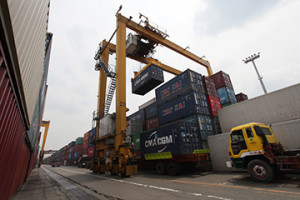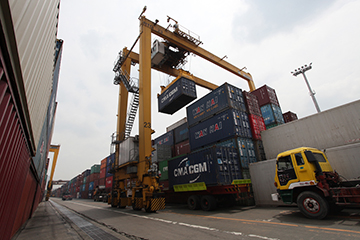
Cargo throughput at Philippine ports grew 4.68% in the first quarter of the year to 44.942 million metric tons (mmt) from 42.942 mmt year-on-year.
The Philippine Ports Authority (PPA) said “the increase could have been higher if not for the day-time truck ban imposed by the City Government of Manila that effectively constricts Manila Ports (from handling) more cargo.”
The agency said the full effect of the ban will largely be felt in the second quarter of the year.
In late February, Manila imposed a truck ban policy which allows trucks to operate on city roads only from 10am-5pm and 10pm-5am.
PPA said the measure resulted in a number of vessels skipping the three Manila Ports—the North Port, the Manila South Harbor and the Manila International Container Terminal— “due to longer turnaround brought by congestion due to the pile-up of containers inside the ports.”
In a statement, PPA general manager Juan Sta. Ana said, “The Manila Ports handle the bulk of our cargoes and while we expect the truck ban to continue, the agency, along with other stakeholders will continue to find ways to reduce the effects of the ban on the overall cargo throughput.”
He added that “despite this minor setback, we continue to maintain a cautious optimism in terms of growth in cargo volume nationwide.”
Foreign cargo throughput for the first quarter rose 4.19% to 24.894 mmt from 23.893 mmt; domestic cargo volume improved 5.3% to 20.058 mmt from 19.048 mmt.
Import volume grew 7.20% to 15.200 mmt from 14.179 mmt while export volume slipped 0.21% to 9.693 mmt from 9.713 mmt.
Strong volume growth was observed in the ports of Iloilo, Puerto Princesa and Ozamiz due to rise in shipment of metals and cement; increase in the volume of export cargoes at the private ports of Puerto Princesa; and greater inbound and outbound domestic cargoes in Ozamiz.
For the period in review, container throughput saw a 4.52% uptick despite flat growth at Manila ports.
MICT handled 426,444 twenty-foot equivalent units (TEUs), Manila South Harbor 202,736 TEUs, and North Port 218,732 TEUs for the first three months of the year.
PPA said 2014 first-quarter volume was “almost identical” to the year-ago figure for Manila ports except for South Harbor which handled 4.4% less from last year’s 211,978 TEUs.
Of the total container throughput, foreign containers accounted for 784,732 TEUs, up 6.8%; and domestic boxes 515,248 TEUs, a 1.22% improvement.
Imports of containerized cargoes expanded 8.25% to 390,499 TEUs while exports posted a 5.4% increment to 394,233 TEUs.
Shipcalls, however, dropped 5.01% to 82,946 calls from 87,321. Domestic vessel calls decreased 4.97% to 80,580 and foreign calls went down 6.45% to 2,366 from 2,529 calls.
Passenger volume also declined 1.71% to 12.391 million from 12.606 million year-on-year. The number of domestic passengers dipped 1.69% to 12.370 million and that of foreign passengers went down 12.29% to 21,495. — Roumina Pablo





